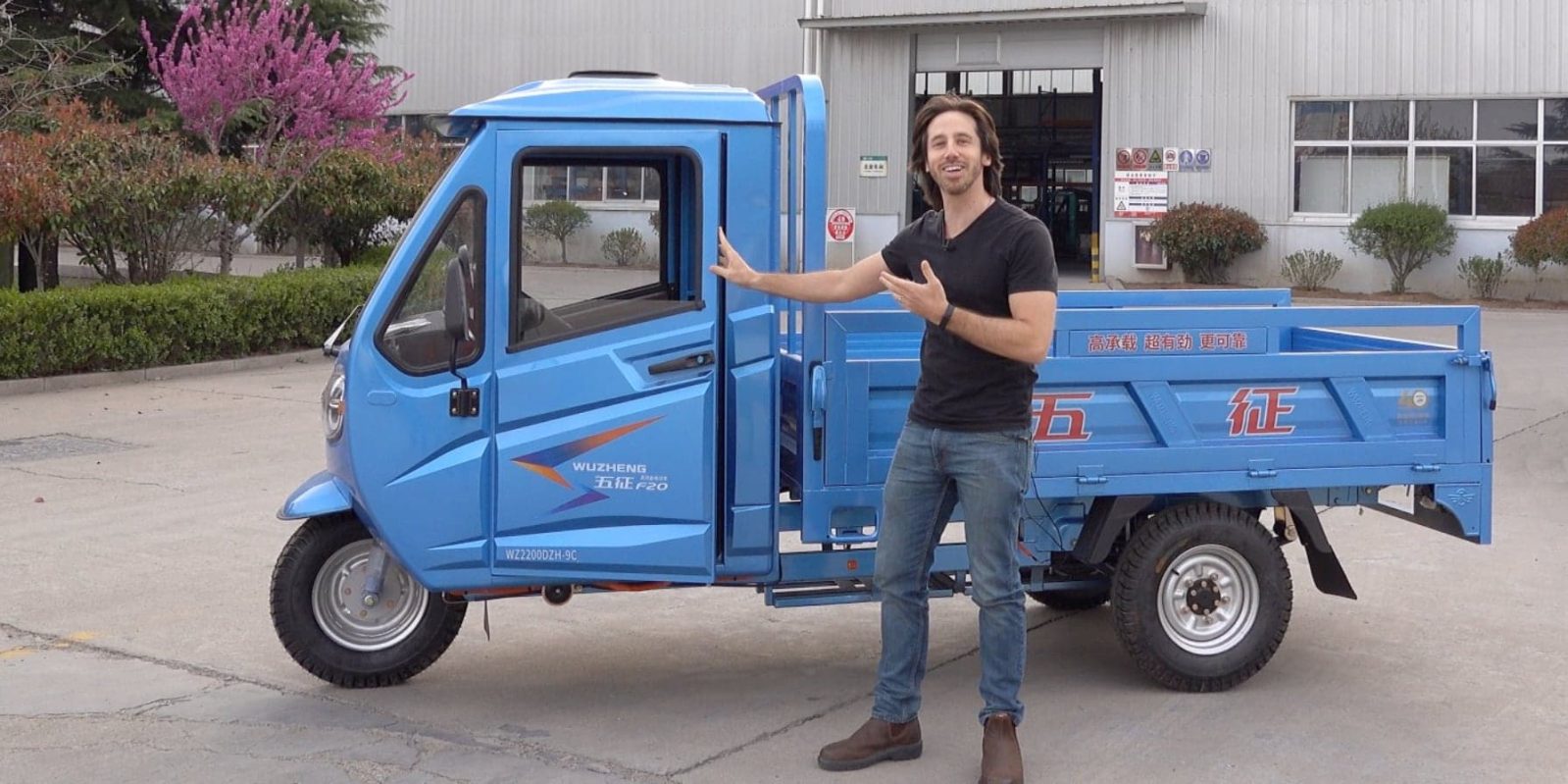
When I recently took a trip to China to see the world of electric micromobility, I was greeted with a wide range of personal electric vehicles. From e-bikes to e-scooters and even e-dirt bikes, I saw it all. But one of the most interesting examples, and clearly the most divergent from our own vehicles in the West, was what I saw while touring Wuzheng’s electric three-wheeler factory.
I know, I know. This isn’t what most of us think of when we hear the words “farm truck.” Trust me, I get it. I spent the first couple decades of my life in the southeastern US, a good ol’ southern boy. I grew up running through cornfields, barrel racing, and taking dates to watch the tractor pulls and demolition derbies at the county fair. In other words, I know rural living and what it means to work with your hands as a way of life. My current truck may be far from the typical work truck you’ll see on most farms and ranches, but I get it.
And so, while taking the bullet trains that cut through extremely rural areas of China, I was amazed to see both sights I recognized well and things that were completely new to most Westerners. At the end of the day, farmers are farmers. Their farmers may swap out our worn-out ball caps for their wider conical straw hats, but they put in the same long days in the fields that we do. More interesting to me though, was what they were using instead of our work trucks.
In the vast landscapes of rural China, electric three-wheeled vehicles seem to have become an indispensable part of daily life for farmers and workers. There, these vehicles are valued for their affordability, versatility, and efficiency.
Farmers use these electric trikes for a wide range of tasks, from transporting their harvests to local markets, to carrying fertilizers, tools, and crops across their fields.
The compact size and robust design of these vehicles make them ideal for steering around the narrow and often unpaved rural roads that characterize much of China’s countryside – places larger trucks would struggle to navigate. And without the need to buy or store expensive diesel, they can charge them up cheaply anywhere they can run an extension cord.
To see how these types of electric three-wheeler farm trucks are built, I went to visit the factory of one of the largest three-wheeler producers in the country, Wuzheng.
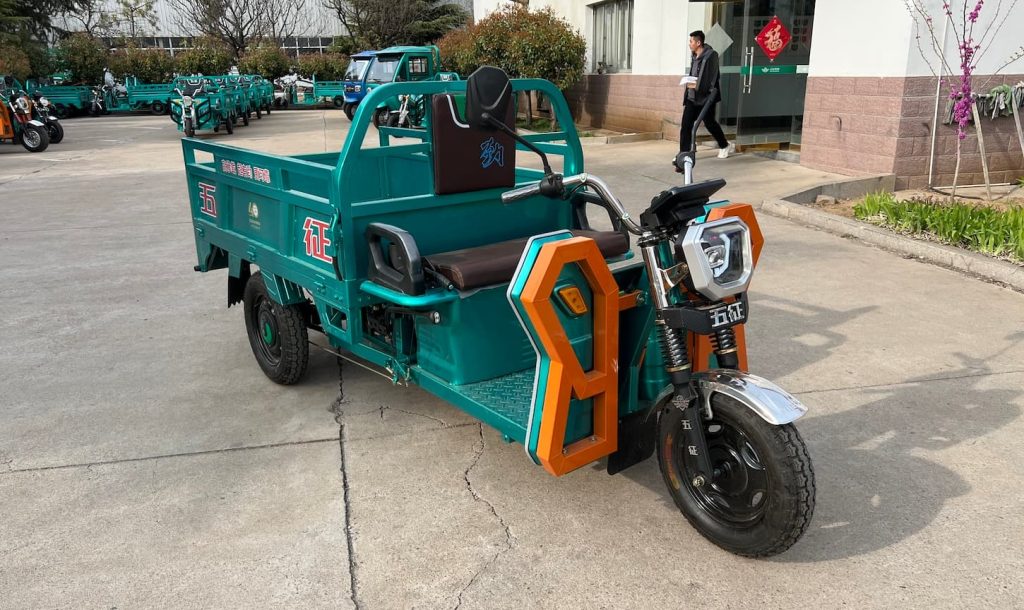
The company knows a thing or two about farm equipment. They’ve been building gas and diesel tractors and farm equipment since 1984, with their first combustion engine three-wheeler coming out around that time. They’ve since switched their three-wheelers over to electric drive, which makes them more reliable and requires less maintenance. Plus, they cost significantly less to own and operate with the reduced maintenance and lower fuel costs of electric vehicles. That reduced cost of ownership is a major reason I saw so many electric three-wheelers all over rural China and used on almost every farm I passed through.
One of the key reasons for the widespread adoption of electric three-wheelers among rural Chinese communities is their cost-effectiveness. Traditional vehicles like tractors or trucks are often prohibitively expensive for small-scale farmers and rural workers. In contrast, electric trikes are significantly cheaper to purchase and maintain. Additionally, the cost of electricity used to charge these vehicles is substantially lower than that of gasoline or diesel, making them an economically sustainable option for daily use. This affordability extends the mobility and operational range of rural workers, enabling them to transport heavier loads over longer distances with minimal expense.
The design is also optimized for daily work. The bed is lower than a typical pickup truck bed, making it easier to load, especially over the long side rails. The three-wheelers usually have tailgates and side gates, allowing them to convert into flat-bed trucks in seconds. The bed almost always tilts, turning them into dump trucks when necessary.
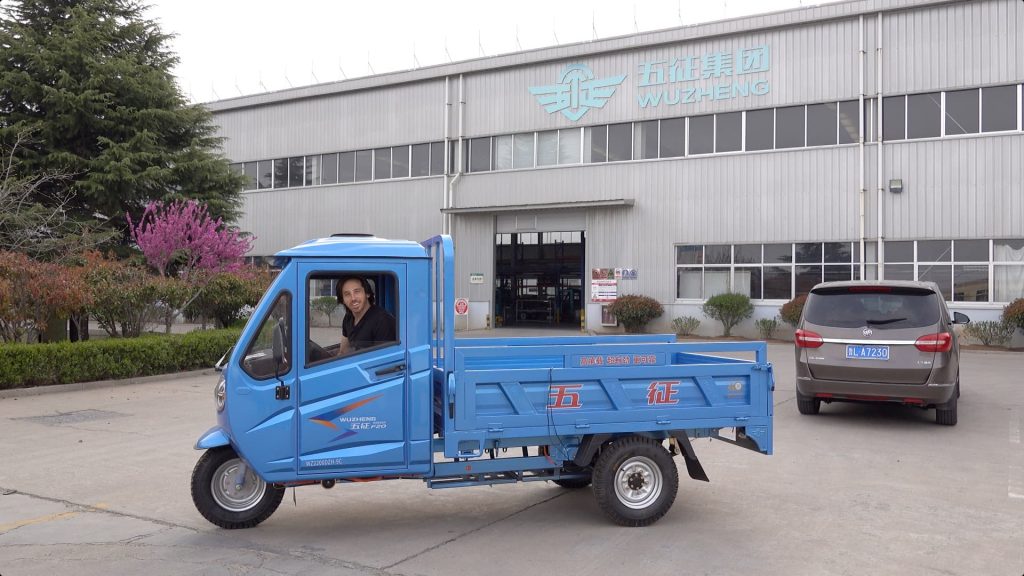
Visiting Wuzheng’s factory gave me a lot of insight into how the company is able to produce hundreds of thousands of these electric three-wheelers every year.
At this single factory, just one of many in Wuzheng’s sprawling grounds, there were a pair of assembly lines running side-by-side. Both lines cranked out electric three-wheelers, with one producing open-top variants and the other producing models with fully enclosed cabs.
Both styles are popular for different use cases, and the underlying frame and components are largely the same. To create both, the company begins with the raw materials in another massive warehouse next door. There, giant spools of steel sheets are cut and stamped into the sheet metal panels surrounding the vehicle.
At the same time, steel tubes are cut, formed, and welded into the frame and subassemblies of the three-wheelers.
The jobs are done mostly manually, with different workers specializing in different aspects, from manning the cutting and forming machines to welding the individual frame members and cab panels. Unlike some other factories we’ve seen with increased levels of automation, the process seems to be completed largely with human workers instead of robotics. As automation is still sweeping across the Chinese manufacturing industry, I wouldn’t be surprised to see more robotic operations added in the coming years.

From there, the frames and bodies are passed on to the coating and painting stage, where they begin to take on their recognizable forms.
The bare chassis almost resembles what we’d consider a ‘normal’ truck body, and it’s not until that single front wheel is added that the trike character shines through.
And that’s exactly what comes next, as those chassis move on to the assembly lines. Here is where they turn from a pile of parts into fully-functional work vehicles.
A series of stations equipped with gantry cranes lower major sections of the vehicles into place as workers manually mount the components.
From there, the vehicles are finished with Wuzheng’s branding and then driven right off the end of the assembly line into the staging yard ahead of final testing and loading onto trucks to distribute them across the country.
Wuzheng has hundreds of dealers spread around the country, and as one of the largest electric three-wheeler makers, sells hundreds of thousands of these machines every year.
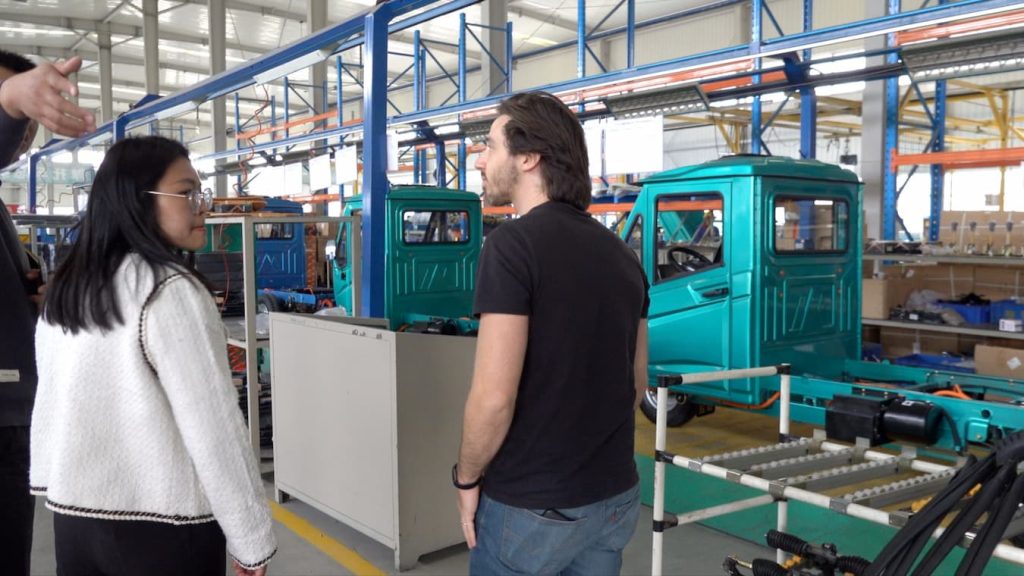
But before two different styles of the company’s machines could make it onto a truck for delivery, I got the chance to borrow them for a few minutes and have my own joyride around the complex.
The first model I tested was an open-top variety, which represents the majority of electric three-wheelers you see in rural areas of China. It’s also the most cost-effective, since you don’t have the extra expense and complexity of an enclosed cab.
Without doors, it’s easy to hop on and off repeatedly, which you very well may be doing as you ride around fields and tend to any number of tasks.
These are usually rated for carrying many hundreds of kilograms and sometimes even over a metric ton (2,200 pounds). Riding around with an empty bed was obviously not taxing the machine, so I asked several of the company’s employees to hop aboard with me. Even with four adult men (or three adult men and one man-child journalist), the performance was unchanged.
And that make sense, since it’s common to see these electric three-wheelers loaded high with heavy cargo such as farm crops, or used for delivering bulk products like cases of heavy bottled drinks. They regularly carry hundreds of kilograms of goods, and so they’re built with torquey electric motors to handle that load.
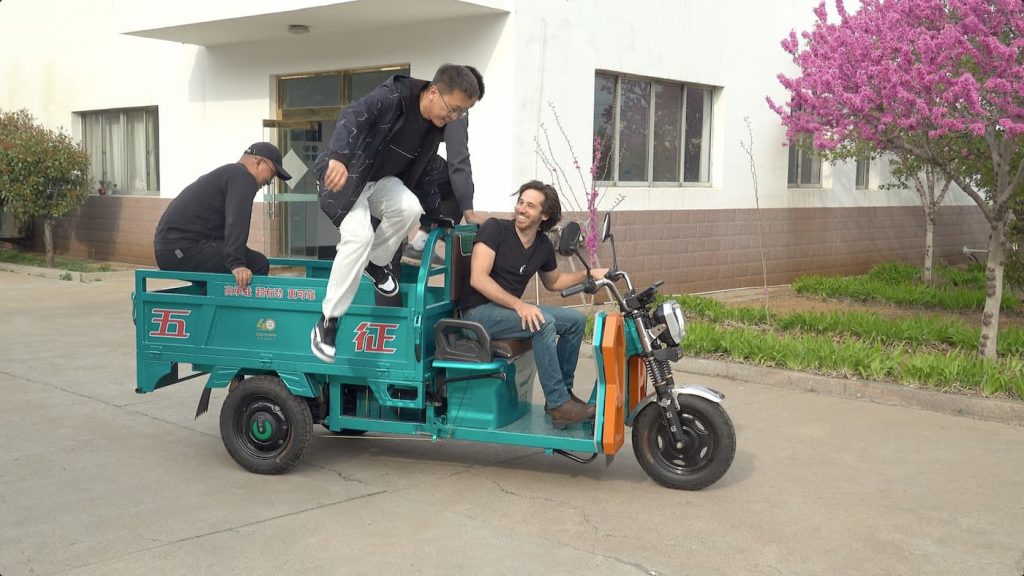
Next, I hopped into an enclosed vehicle. This time, the cab included doors and a weather-sealed interior. Interestingly, the handlebars for the single front wheel were replaced by a steering wheel. Since you couldn’t see the single wheel in front of you, it really felt more like a standard four-wheeled vehicle from the inside.
Again, the power was more than sufficient, and it handled quite nicely. Neither machine had a particularly sophisticated suspension setup, but they were perfectly fine for riding around the bumpy complex we were touring.
The enclosed version obviously offers a big advantage during inclement weather, allowing riders to stay dry during rain or even use air-conditioning during hot summers.
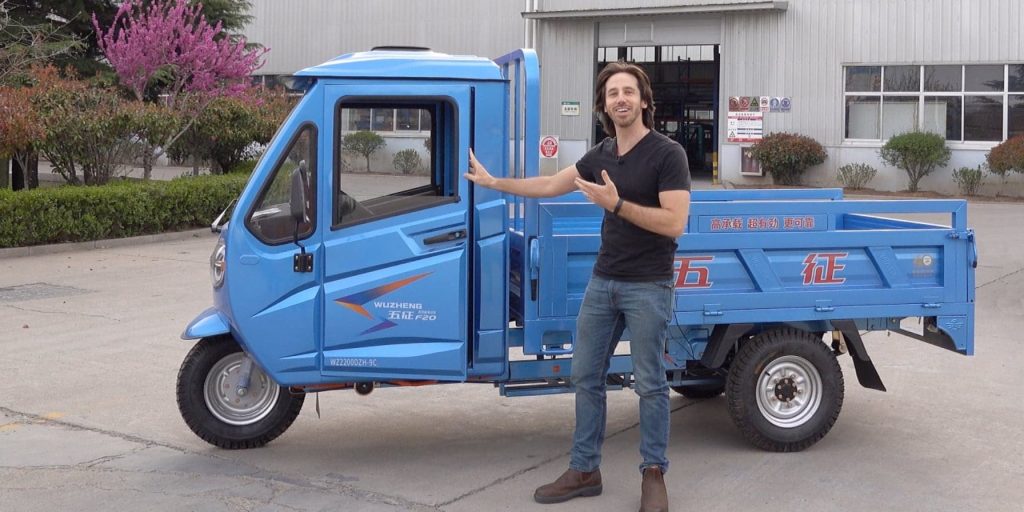
The main question most people are probably wondering about is stability. We all know that three-wheelers aren’t as stable as four-wheelers, so what about tip-overs?
I can tell you that from testing the vehicles myself and doing parking lot donuts, I never felt like I had any issues with rollover. The machines put their heavy batteries low on the chassis, and the motor is mounted even lower on the axle.
That means the machine’s center of gravity is so low that you’d probably have to hit a hairpin turn at speeds faster than these are capable of to actually roll one.
This isn’t like the electric tricycle e-bikes I often cover, which can easily lift a wheel in sharp turns. For those, you’ve got a rider that weighs more than the machine sitting high up above the centerline axis. With these Chinese farm trucks, your rider is a small fraction of the total vehicle weight, which is designed to keep a super low center of gravity and optimize stability. When the majority of your weight is axle height, tipping the vehicle over is quite a chore.

Visiting Wuzheng’s factory and experiencing this style of work vehicle firsthand was an eye-opening experience. Electric three-wheeled vehicles like these have become a crucial tool for Chinese farmers and rural workers due to their affordability, efficiency, environmental benefits, and practicality.
As rural China continues to modernize and seek sustainable development, these vehicles will likely remain a cornerstone of daily life, facilitating agricultural productivity and improving the quality of life for millions of people across the countryside. With prices starting at less than the equivalent of a thousand US dollars, these vehicles are a much more affordable and accessible option for average working families.
And just because they aren’t shaped like the farm trucks we’re used to, doesn’t mean they don’t move the same bales of hale or bushels of corn. They just do it with fewer wheels on the ground and more wind in your hair.
FTC: We use income earning auto affiliate links. More.




Comments